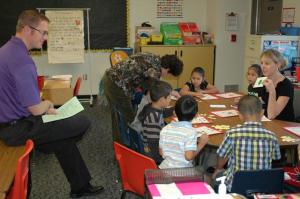
Abstract
The aim of this paper is to study the effect and role of using technology in learning English. The research discusses various means that students of Effat University use to improve their skills in learning the English language including Movies, Dictionaries, YouTube, BBC Learning and the Effortless English program. Six participants are currently involved in this study. Students were asked questions in semi-structured interviews. Results indicate that technology helps the learners to acquire a language. Among these technologies, students showed considerable advances in their listening, reading and speaking ability. Also, they showed more improvement in vocabulary and comprehension.
Keywords: technology, learning language, computer software, online tools
Introduction
Technology plays a major role in our every day life and allows people to improve their surroundings. The education system has been inundated as well, and technological development has become one of the most important measurements of a nation’s progress.
Learning a language is an ongoing process that does not stop at a certain benchmark, but continues throughout life. Today, technology provides students numerous approaches to learn the English Language. These ways may be more convenient, and also may fit the learning styles of a student who wants to learn English. The computer is a modern educational tool in the teaching of language, an advance that helps make education fun and may also create a positive learning environment. Also, it provides students with new experiences and learning opportunities to help make different decisions and to think critically. The World Wide Web increases student’s interest and also offers many software packages that are designed for students who want to learn a language.
Literature Review
Rationale behind learning English as a foreign language:
The English language is an integral part of people’s lives today, and they are motivated to learn it for different reasons. It is considered a second language in many parts of the world. Advancements in almost every discipline necessitate learning English, as most research is published in the language, leading it to be regarded as an important and universal language. Additionally, many schools and higher education systems use it as the medium of instruction (Morris and Maxey, 2014).
Learning the English language is not an easy task (Ishihara and Cohen, 2014). Teaching methods for the language have also undergone myriad changes, and each one has been geared toward facilitation of the students’ understanding. The conventional teaching method was partnered with such mediums as radio, television and finally, information technology. The role of technology has been realized as vital in education of the English language and many areas in the world have come to realize the importance of information technology within the context of English education. These have facilitated and augmented English learning to a great extent. Indeed, Graddol (2012: 18) states “technology lies at the heart of the globalization process, affecting work, education and culture”. This is especially true in current times, while technology is indeed reshaping the world we live in through each and every facet of an individual’s life.
Role of technology in learning English:
The important role that information technology plays in English education cannot be over-emphasized in current times. The most obvious advantage of using the technological medium for language instruction is ease and timeliness of access. It is helpful for both the teachers and students. Use of digital libraries as well as dictionaries and thesaurus’ have facilitated quicker learning and has substantially improved learners’ vocabularies. Furthermore, the use of such technologies within the educational mediums has also facilitated fast, interactive, and more integrated learning.
Language learning has changed substantially with the use of information technologies. The medium provides myriad options that make for interesting learning avenues while producing better results as compared to conventional learning methods. Teachers make use of multimedia facilities to electronically educate their students, while keeping them abreast of the latest trends within their disciplines (Huang et al, 2012). The conventional system of learning, where the teacher lectured and many students failed to listen or pay attention, is quickly being replaced by integrated technologies for a class that is more responsive, both in terms of learning and in terms of responding to the challenges posed by the linguistic curriculum. A higher number of students are engaged than was previously possible.
Distance learning for English language curriculums is also facilitated through the use of information technology. Interactive media allow for real time learning, again facilitating the English language learning process.
Nomas (2013), sees a great benefit in using modern technology for learning English as a second language. He discusses the various means by which English language learners, including the use of web sites directed at English language learning, computer assisted language learning programs, videos, audio resources, software for making innovative presentations, dictionaries, chat features and email. The research is rooted in the case study tradition, looks at how a group of students used technology in their classroom in learning the English language. In the recommendations for future research, Nomas draws attention to the current problems with technology in the classroom and how these can be accounted for. Such problems are the division between theory and practice in the modern classroom. He calls for the integration of technology into the practice of language learning these classrooms, and that the teacher educators should also account for these types of innovations as well.
According to Arrabtah and Nusour (2012), technology, specifically computers and the Internet, have a positive impact upon students learning Arabic language grammar at Princess Alia University College at Al-Balqa University. The quantitative based research methodology of the study looked at the descriptive and inferential analysis of a sample drawn from students in an Arabic grammar class at the university. Between the control and experimental group, Analysis of variance between GPA mean measures indicated that there was a statistically significant difference in pre and post test scores in the experimental group, but that there was no statistically significant difference between grade point average achievements (GPA). The researchers concluded that there was enough evidence to encourage the use of technology on Arabic grammar learning environments.
Amiri and Branch (2012), see the study of digital technologies in teaching and learning English as integral to improving and making education more efficient. Through a case study of students at a school in Tehran, Iran. The researchers argue that students are much more engaged and interested in the subject matter of learning English when technology is incorporated into the classroom structure in different ways. They cite the use of instant messenger, Ipods for podcasts, email, and other tools as important aspects of technology being integrated into classrooms.
Data Sources
The main data source in this research results from semi-structured interviews. Semi-structured interviews allow for a flexible data collection process in which the interviewer does not follow a formalized list of questions. Instead, he or she has a list of general topics, which guide the questioning through open-ended questions. Through this semi-structured interview process, the interviewer will tailor her questions to the specific interviewee, allowing for a more fluid conversation. The semi-structured interview format also permits two-way communication; both the interviewer and interviewee can ask each other question.
Methodology
The study was conducted with the cooperation of six Saudi students between 20-24 years of age. The participants were asked the following questions:
- Do you use a technology in learning English?
- What technology do you use for learning English?
- How do you use it?
- Do you feel any progress in your English level?
Results and Discussion
With the growth of technology, people can choose their way to learn a language. These days most people are hooked on smart phones and social media, and we can find many interesting ways that technology offers improved methods for students to learn the English language. Von Ahn, who founded DuoLingo, says “most people who want to learn a language don`t have the money but becoming proficient in language can cost a lot.” it could be apps or interactive software that connect the gaps between low income students and language acquisition. Rosetta Stone Inc., which is a Software Company that improves language, has created many platforms suited with the tools of language learning.
During the interview, the girls mentioned many tools, websites, and apps that enhanced their language-learning process, which are listed below.
Movies
Numerous students said the most effective way of learning a foreign language is by watching a movie. Movies may be is considered an important source for learning the English language. Through this method, the students can learn English in a fun way by relaxing on her seat in her house and watching her favorite movie. Sara and Reem have watched movies on MBC 2 and MBC action. They noticed improvement in their listening and speaking skills. While Raneem downloaded the movies on her computer, she watched movies with English subtitles. She said she gained more vocabulary and can understands more than before.
Dictionary
The dictionary is an important tool for many English language learners and also for native English speakers. It offers definitions of a word if one does not know what it means. It also offers synonyms, or words with similar meanings.
For Nada, dictionary.com was an important website due to the many new words that she encountered in academic language or in new areas of education. This website helped her to clarify new words found in the learning process. This website is useful in helping academics to define terms, use synonyms, and clarify concepts used in the English language.
Farah used Google translator as an app in her phone or through the website. She used it for the majority of her courses to find difficult words, definitions, and examples for idioms, synonyms, and antonyms.
YouTube
YouTube is a valuable website for students that cannot process live or in real time. It is a good website for teachers, students, or anyone who wants to learn a process or engage with a research topic .The quality of the videos may vary, but the large number of topics and presentations make the chances of finding a quality presentation high. According to Snelson (2011), the theme of YouTube is as an open sourced video-based format, which makes for a visual learning experience, and this simulates a live presentation through video format.
According to Sara, a student in the English department, “in my own academic life, I use YouTube as an app in my phone to see videos relating to syntax and semantics. I also use this resource to study theories for language acquisition.”
BBC Learning
BBC learning is a free resource that is easy to use in terms of searching for content. The website content of the platform is organized according to the developmental level of students. There are many interactive resources for language acquisition, children’s research, and links to other follow up sites. The reliability of the British Broadcasting Corporation is well known as a trusted news source of respected renown, a reputation that has been extended to their educational site (Whitton, 2009).
Reem uses BBC learning to read and watch various resources about language learning. At other times she uses BBC learning website to practice language skills. She feels that there is a progress in her accent and reading skill since she can read an article and understand many words without any help.
Effortless English program
Effortless English is a helpful application for many English language learners. The application offers vocabulary Lessons, and listening modules, which involve question and answer mini stories, point of view story lessons and audio articles.
Bashair liked Hoge `s way in teaching who used a listening approach. She downloaded the application on her computer and MP3 player (IPod). This program helped her to listen to the lessons anywhere and at any time. It supported her to overcome nervousness and fear when she spoke English. Also, the audio tracks of the vocabulary lessons helped her to improve listening and speaking skills.
The responses from this study revealed that for many of the girls, technology is considered an important source in learning the English language.. I noticed that each student had her own way of using technology to learn a language. All the students agreed that using many apps on their phones, computers, Ipads or MP3 players gave them excellent opportunities for learning a language. The results demonstrate that these examples of technology helped these learners to acquire a language. The majority of the students showed a improvements in their listening, reading and speaking abilities. Also, they showed more improvement in vocabulary and overall comprehension.
Conclusion
Technology plays a major role in learning the English language among Effat University students. Students prefer learning English while using technology due to the useful skills that they gained throughout the learning. Utilizing online tools and application software helped students to learn more easily and also to acquire English language skills, which are valuable.
References
About – Learn to Speak English Powerfully With Effortless English. (n.d.).
Retrieved from http://effortlessenglishclub.com/about
Amiri, E., & Branch, L. (2012). A Study of The Application of Digital Technologies In
Teaching and Learning English Language And Literature. INTERNATIONAL JOURNAL OF SCIENTIFIC & TECHNOLOGY RESEARCH, 1(5). Retrieved from http://www.ijstr.org/final-print/june2012/A-Study-of-The-Application-of-Digital-Technologies-In-Teaching-And-Learning-English-Language-And-Literature.pdf
Arrabtah, A., & Nusour, T. (2012). Using Technology For Teaching Arabic
Language Grammar. Journal of International Education Research, 8(4).
Codrea-Rado, A. (2014). Can I successfully learn a language online? Retrieved
from http://www.theguardian.com/education/2014/feb/21/can-i-learn-a-language-online
Graddol, D. (2012). The impact of macro socioeconomic trends on the future of
the English language.
Morris, M., & Maxey, S. (2014). The Importance of English Language Competency
in the Academic Success of International Accounting Students.Journal of Education for Business, 89(4), 178-185.
Nomass, B. (2013). The Impact of Using Technology in Teaching English as a
Second Language. English Language and Literature Studies, 3. Retrieved from file:///Users/Salmah/Downloads/25002-83673-2-PB (3).pdf
Rosetta Stone (company). (2014, December 11). In Wikipedia, The Free
Encyclopedia. Retrieved from http://en.wikipedia.org/w/index.php?title=Rosetta_Stone_(company)&oldid=637673412
Snelson, C. (2011). YouTube across the disciplines: A review of the literature. Journal of Online Learning and Teaching, 1(7), 159-169
Whitton, N. (2009, April). Review of the research literature on the impact of multimedia revision web materials: Report for the BBC. Manchester Metropolitan University. Accessed from http://downloads.bbc.co.uk/learning/learningoverview/research_report.pdf.
Ybarra, R., & Green, T. (2003). Using Technology to Help ESL/EFL Students
Develop Language Skills. The Internet TESL Journal, 3. Retrieved from http://iteslj.org/Articles/Ybarra-Technology.html
The Art of Scientific Communication





